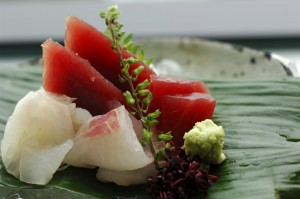I’ve been a bit distracted in the last couple of weeks and hence a lackluster post performance. So time to get back to the ocean nitty gritty…
 And what better way to start anew than with something to ease our appetites. As I glance over the virtual menu I decide what the hell, “Waiter, I’ll take the tuna.” I know I railed against overfishing, reported on the decreasing numbers of tuna, and have heard conservation organizations ask me to stay away from bluefin but no worries as the menu indicates nothing about item #13 being southern bluefin. Oops, I guess he didn’t hear me, “WAITER, I’LL TAKE #13, THE CRITICALLY ENDANGERED TUNA…PLEASE.”
And what better way to start anew than with something to ease our appetites. As I glance over the virtual menu I decide what the hell, “Waiter, I’ll take the tuna.” I know I railed against overfishing, reported on the decreasing numbers of tuna, and have heard conservation organizations ask me to stay away from bluefin but no worries as the menu indicates nothing about item #13 being southern bluefin. Oops, I guess he didn’t hear me, “WAITER, I’LL TAKE #13, THE CRITICALLY ENDANGERED TUNA…PLEASE.”
Yep, you heard it right that time. A new study published Wednesday (Nov. 18) in PLoS has found that piece of tuna you just ordered and most likely eaten was potentially an endangered species. And if I actually ate tuna sushi, that would be enough to make me sicker than ingesting a helping of week old sashimi leftovers.
Now that we know I’m safe from feelings of guilt and a potential bout of food poisoning, I’ll move on with the findings. With a background in molecular biology, I love it when genetics rears its head in the world of conservation. In this particular case, the researchers collected tuna samples from restaurants over a 7 month period in 2008 and, for the sake of brevity, used the obtained DNA to identify the species. Here is a summary of their results:
-A piece of tuna sushi has the potential to be an endangered species, a fraud, or a health hazard. All three of these cases were uncovered in this study. Nineteen (out of 31) restaurant establishments were unable to clarify or misrepresented what species they sold.
-Twenty-two of 68 samples were sold as species that were contradicted by molecular identification, while six samples were sold as ‘‘tuna’’ or ‘‘red tuna.’’
-Five out of nine samples sold as a variant of ‘‘white tuna’’ were not albacore (T. alalunga), but escolar (Lepidocybium flavorunneum), a gempylid species banned for sale in Italy and Japan due to health concerns.
-Nineteen samples were northern bluefin tuna (T. thynnus) or the critically endangered southern bluefin tuna (T. maccoyii), though nine restaurants that sold these species did not state these species on their menus.
The high stakes, money making tuna market has effectively become a game of chance for the consumer. And when you can’t trust the restaurant, the menu, or the staff, perhaps it is better to err on the side of caution. Just something to think about the next time you pick up your chop sticks.
![]()
Lowenstein, J., Amato, G., & Kolokotronis, S. (2009). The Real maccoyii: Identifying Tuna Sushi with DNA Barcodes – Contrasting Characteristic Attributes and Genetic Distances PLoS ONE, 4 (11) DOI: 10.1371/journal.pone.0007866


[…] This post was Twitted by therightblue […]
Social comments and analytics for this post…
This post was mentioned on Twitter by journowl: Study finds ‘Sashimi may be an endangered species’ http://bit.ly/2bMYGS #ocean #oceans #wildlife…
[…] by a specific name, such as bluefin or bigeye tuna. Wired Science, LiveScience, Uncommon Ground, Thriving Oceans and the Barcode Blog all discussed the […]
boy oh boy, i love sushi but now i should be aware of what i order.
Hmmm I’m big on protecting our endangered species, but I also love my sashimi. I don’t know what to do… 🙁